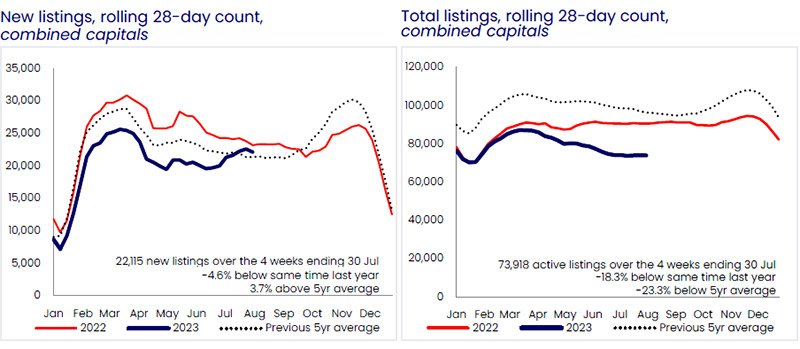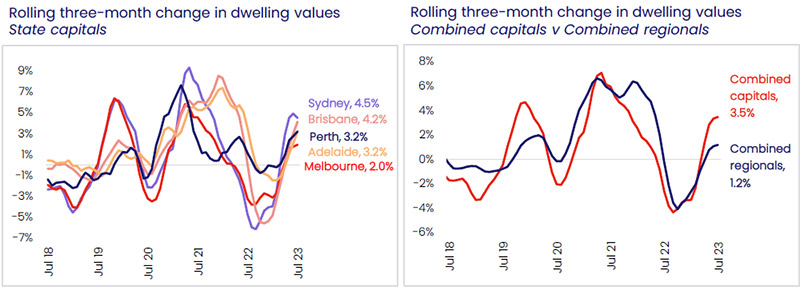Property prices notch up fifth straight month of increases
Property prices nationally rose 0.7 per cent in July, marking a fifth consecutive month of housing value recovery.
Adelaide and Perth were the standout property markets over the past month as real estate values nationally recorded a fifth consecutive month of increases.
CoreLogic’s national Home Value Index rose 0.7 per cent in July, as property prices continued to retrace the 9.1 per cent decline from the record highs of April 2022.
Nationally, prices are up 4.1 per cent since February but remain 5.3 per cent below the April 2022 peak. Only Perth, Adelaide and regional South Australia recorded a new cyclical high in dwelling values through July.
Regional values continued to lag behind the capitals, with the combined regionals index rising 0.2 per cent in July compared with a 0.8 per cent increase across the combined capitals index.
Every rest-of-state region recorded a smaller change in dwelling values through July relative to the capital city, reflecting milder housing demand across regional Australia as demographic patterns normalise.

Source: Corelogic.
CoreLogic Research Director, Tim Lawless, noted the most substantial reduction in growth has occurred in Sydney.
“After leading the upswing, the monthly pace of growth in Sydney housing values has halved from a recent high of 1.8 per cent in May to 0.9 per cent in July.
“Sydney has also seen a significant rise in the number of fresh listings added to the market, 9.9 per cent higher than the same time last year and 18.0 per cent above the previous five-year average.
“An increased flow of new listings provides more choice and may be working to reduce some of the urgency felt among prospective buyers,” he said.
Brisbane and Adelaide saw the monthly pace of growth accelerate in July, leading the pace of gains across the capitals with housing values up 1.4 per cent across both cities.

Source: Corelogic.
Although the trend in new listings has risen in these cities, Mr Lawless said the number remains well below levels from a year ago and the previous five-year average.
Canberra was the only capital city to record a decline in values in July, down 0.1 per cent, while Hobart values were unchanged.
Anticipated price falls didn’t materialise
At the start of 2023 a majority of property forecasters were tipping that prices would decline significantly, with some banks and investment enterprises saying they could fall as much as 20 per cent.
Market conditions, however, continue to be solid in the face of the low supply of sales listings around the nation.
Property Investment Professionals of Australia (PIPA) Chair, Nicola McDougall, said the significant price falls simply did not materialise in many property markets – even with the most rapid increase in interest rates in a generation.
“Of course, part of the reason why prices have been strengthening is the significant number of overseas migrants – some half a million – who have landed on our shores within the past year or two, which is also causing rental markets to continue to struggle with a critical undersupply of stock,” she said.

Source: Corelogic.
Ms McDougall said as well as healthy market conditions, it appeared that the rising interest rate cycle may have come to an end.
“The Reserve Bank of Australia took its foot off the throttle in early July and held the cash rate steady at 4.1 per cent, which provided some confidence to property buyers around the nation,” Ms McDougall said.
“The June quarter inflation reading also came in well under market expectations at six per cent and with it highly possible we are at, or near, the peak of the cash rate.”
Sydney property price growing slowing
Sydney was the only city where the flow of fresh stock to market was higher than a year ago (+9.9%).
Victor Kumar, Director, Right Property Group, said the New South Wales housing market had defied expectations and proven quite resilient.
“Despite rapid rate rises and the so-called mortgage cliff, the market has carved itself into three distinct categories – the affordable, below $1.5 million corridors; the above $1.5 million areas; and the regionals.
“The everchanging landscape and dynamics is influenced by various factors such as economic conditions like the end of fixed rates and the high level of inflation, government policies, buyer preferences and affordability.
“Compound that with a strong immigration factor, and we have a stabilisation of value despite the negative economic and affordability outlook.
“Selling agents that were expecting a whole raft of properties to hit the market, as they report fielding increasing calls for market appraisals, are still to bring these properties on the market.
“Owners struggle to rationalise selling their properties, as they cannot qualify for a new loan at the same or higher level under the current lending constraints, and renting is also a struggle, with a strong shortage in most areas,” he said.
Brisbane housing in limited supply
Meighan Wells, Founder, Property Pursuit Advisors, said supply in Brisbane was as low as she had seen in 20 years.
“At the heart of it, the Brisbane is still severely undersupplied in certain locations for specific property types and demand is not abating.”
She said people have been flocking to Queensland over the past two and a half years and no one is leaving.
“Pre-Covid, population fluctuations were common – people would come, and people would go.
“One of the common reasons for departure was to seek higher paying job opportunities interstate or overseas but with the ability to secure well-paying corporate jobs that have work-from-home, or hybrid arrangements, the requirement to relocate away from the Sunshine State has disappeared.
“The challenge for quality established housing supply is that no-one is selling until they can buy something else but no-one is leaving so we now have a bottleneck of owners who won’t sell until they can buy but can’t find anything to buy until someone leaves, and no-one is leaving and around and around it goes.”
Perth has strongest rental conditions
The strongest rental conditions nationally continue to be seen across the unit sector, where rents were up 2.9 per cent over the three months to July nationally, compared with a 1.9 per cent rise in house rents. Across the capital city and rest-of-state regions, the unit markets of Perth (4.3 per cent), Melbourne (4.0 per cent) and Brisbane (3.8 per cent) stand out with the fastest rate of rental growth over the rolling quarter.
Paul White, Director, aussieproperty.com, stressed that there was still a lack of stock in the Perth sales market and properties are selling very quickly.
That lack of supply was particularly keenly felt in the rental market, where investors had sold up in the face of tighter rental regulations and higher interest rates.
“Interest still remains very high for homes around the $500 to $600 range, with enquiries in the hundreds for each property, although that is still fewer than six months ago.
“City apartments are continuing to rent really quickly with a high amount of enquires and rents are still increasing, although not as dramatically as the last quarter.”
Mr White said a large majority of applicants are still desperately looking for a home.
“We see behaviour that reflects this constantly at home opens and in applications.”





















